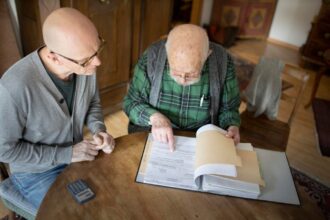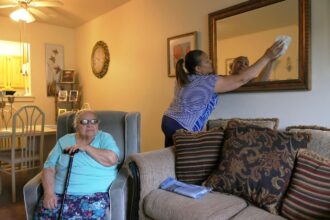Why is it so hard for people in their 60s, 70s and even 80s to admit they are changing with age? Believe me, I hate “ageism” as much as the next person, but fighting ageism doesn’t need to be synonymous with denial of the reality of aging, especially by those who have crossed the age of Medicare qualification.
AARP has been on a crusade to help people “age in place” for at least a decade now, and many people are planning on doing just that. Fine. But aging in place is about more than removing area rugs, widening doorways, and reducing clutter. Often it means taking a good hard look at your home of twenty, thirty, or forty-something years and acknowledging that it is a totally inappropriate structure for anyone beyond their seventh or eighth decade.
I know two couples, both in their seventies, who decided to move. Did they move to a one-level home? No. One couple lost their home in a fire and decided to purchase a new one rather than rebuild. What did they buy? A three-story home on a half-acre lot. Sure enough, about two years in to that little odyssey, one of them was incapacitated by an illness and they had to sell and move again. The second couple, also in their seventies, decided to try living in another city and state for a while: Portland, Oregon in this case. What did they purchase? A two-story home with a basement and a spiral staircase going to the second floor. They have had to turn what was to be a first-floor office into a bedroom on two occasions, both connected with recovery from falls.
And then there is the issue of dogs. Yes, dogs. I love dogs; I have had many beloved canines in my life and fell in love with all of them, including the adorable 20-lb. mixed-breed rescue that currently shares a home with my husband and me. We haven’t always had small dogs. When we were in our thirties and forties, we had a wonderful 65-lb. yellow lab. Then, in our fifties and early sixties we had a 45-lb. mutt. I believe these choices have been smart. They are all part of my own effort not to be in denial about the changes that are happening to our bodies as we age.
Prior to our making the choices above, we saw some of our friends make choices that in retrospect do not seem very smart. One mid-70s couple we know recently moved to a coastal town. Yes, they bought a two-story home, but at least it has a bedroom and bathroom on the main floor. They also decided it was time for another dog to enter their lives. They went to the nearby animal shelter and came home with a 70-lb. black dog they thought was a one-year old “gentle black lab.” Even that was not a particularly smart choice in my way of thinking, but that dog turned out to be mostly Australian Cattle Dog, a very strong and strong-willed herding breed. When we visited them, one of these friends told us it was her first day out of a back brace. Yup, the dog had pulled her over and she had landed on her back.
I see these stories playing out over and over and it’s embarrassing to see my friends being so blind to the changes in their bodies as they are getting older, and the need to modify their lifestyles accordingly. I believe people are not only in denial of the changes they are experiencing, but have become attached to a particular image of themselves that includes having a certain breed of dog or a huge property or living on a large property 20 miles outside of town.
Unfortunately, it often takes an injury to be the wake-up call that some behavior needs to be modified or eliminated altogether. As I write this, a good friend has just been air-evacuated home from Europe because of an accident that was not at all her fault. It could have happened to anyone of any age. However, she is 74 and because she and her husband own and live in a tri-level house, she will not be able to recuperate at home from the multiple fractures to her pelvis and her arm. She will have to go to a rehab hospital for several weeks until she can both heal and learn, with the help of a physical therapist, to maneuver up and down stairs.
If you have made it to the end of this post, take a look at the following questions. They may help you re-evaluate a few things.
- How will your current house work for you if you or your partner encounter mobility issues, permanent or temporary?
- What aches and pains or other changes (vision, hearing, etc.) are you starting to experience that you are ignoring?
- What changes are you noticing in your partner or a friend that they are ignoring or refusing to discuss?
- Are there some changes you have been contemplating, but continue to postpone for one reason or another?
Everyone is aging. There is no basis for argument about that. But after age 60, there is smart aging and not-so-smart aging. It shows up in the choices we make–or fail to make–as the years go by.
Read the full article here










